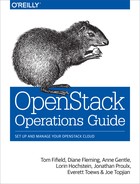0%
27Chapters
0-1Hours read
0kTotal Words
Book Description
Design, deploy, and maintain your own private or public Infrastructure as a Service (IaaS), using the open source OpenStack platform. In this practical guide, experienced developers and OpenStack contributors show you how to build clouds based on reference architectures, as well as how to perform daily administration tasks.
Table of Contents
- Acknowledgments
- Preface
- Provisioning and Deployment
- Cloud Controller Design
- Scaling
- Compute Nodes
- Storage Decisions
- Network Design
- Example Architecture
- Lay of the Land
- Managing Projects and Users
- User-facing Operations
- Maintenance, Failures, and Debugging
- Network Troubleshooting
- Logging and Monitoring
- Backup and Recovery
- Customize
- Upstream OpenStack
- Advanced Configuration
- Use Cases
- Tales From the Cryp^H^H^H^H Cloud
- Resources
- Glossary
